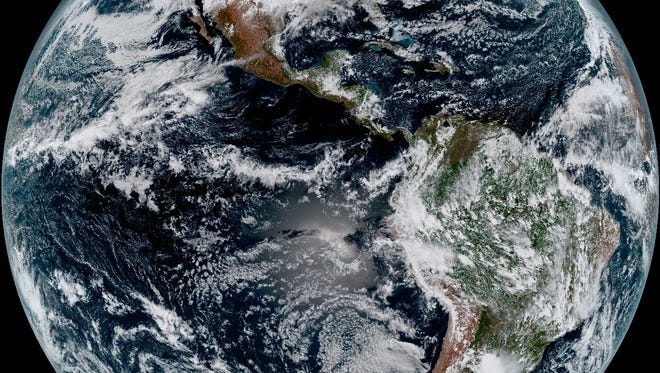NEWS
A first look at NOAA’s GOES-16 satellite images of Earth

GOES-16 captured this view of the moon as it looked across the surface of the Earth on Jan. 15, 2017. Like earlier GOES satellites, GOES-16 will use the moon for calibration.
National Oceanic And Atmospheric Administration
The Saharan Dust Layer can be discerned in the far right edge of this image of Earth. This dry air from the coast of Africa can have impacts on tropical cyclone intensity and formation. GOES-16Õs ability to observe this phenomenon with its 16 spectral channels will enable forecasters to study related hurricane intensification as storms approach North America. These additional channels will also enable forecasters to differentiate between clouds from dust, or snow from clouds.
National Oceanic And Atmospheric Administration
NOAA's GOES-16 satellite captures a view of the entire Western Hemisphere, including our neighbors here in Argentina, South America. Storms are evident in the northeast and mountain wave clouds can be seen in the southwest.
National Oceanic And Atmospheric Administration
This area of Mexico and Central America is seen from GOES-16 with a largely cloud-free view. A fire and its associated smoke are evident over southern Mexico near the coast.
National Oceanic And Atmospheric Administration
From its central location, GOES-16 captured this image of the west coast of the United States and the Baja Peninsula in Mexico. Once GOES-16 is determined to be operational as either GOES-East or GOES-West, GOES-S, the next spacecraft in the series, which is planned for launch in spring 2018 will be moved into the other operational position as GOES-17.
National Oceanic And Atmospheric Administration
In May 2017, NOAA will announce the planned location for GOES-16. By November 2017,GOES-16 will be operational as either the GOES-East or GOES-West satellite. At its current check out location the satellite captured this image of the Caribbean and Florida. Here the satellite captures the shallows waters of the Caribbean.
National Oceanic And Atmospheric Administration
This composite color full-disk visible image is from 1:07 p.m. ET on Jan. 15, 2017, and was created using several of the 16 spectral channels available on the GOES-16 Advanced Baseline Imager (ABI) instrument. The image shows North and South America and the surrounding oceans. GOES-16 observes Earth from an equatorial view approximately 22,300 miles high, creating full disk images like these, extending from the coast of West Africa, to Guam, and everything in between.
National Oceanic And Atmospheric Administration
This image clearly shows the significant storm system that crossed North America that caused freezing and ice that resulted in dangerous conditions across the United States Jan 15, 2017, resulting in loss of life. GOES-16 will offer three times more spectral channels with four times greater resolution, five times faster than ever before.
National Oceanic And Atmospheric Administration
On Jan. 15, 2017, severe weather moved across the central United States before passing through the Northeast on Jan. 16, 2017, and Jan. 17, 2017, where it resulted in wet and wintry weather for travelers across the region.
National Oceanic And Atmospheric Administration
This 16-panel image shows the continental United States in the two visible, four near-infrared and 10 infrared channels on ABI. These channels help forecasters distinguish between differences in the atmosphere like clouds, water vapor, smoke, ice and volcanic ash. GOES-16 has three times more spectral channels than earlier generations of GOES satellites.
NOAA